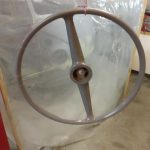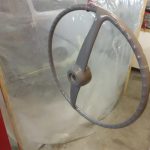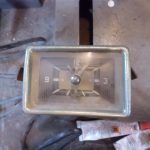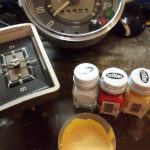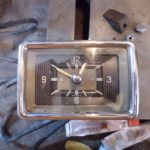Steering Wheel Primer
Speedometer and Clock Restoration
Taking another break from painting/sanding, I worked on cleaning up the speedometer and clock. The speedometer was in generally OK condition but needed some polishing. In the process of disassembly and polishing the bezel and glass I found that the light ring needed repainting. The light ring is the khaki-colored ring between the glass and gauge face, it reflects light from the back of the gauge housing onto the gauge face. In other words the gauges do not have illuminated numbers like a modern car, instead the effect is more like holding up a flashlight to the gauge face.
The clock had the same cosmetic issues with the bezel, lens, and light ring. Additionally the clock’s hands had faded badly and the mechanism was not working when connected to 12V. The hands were repainted by carefully mixing model airplane paint to match the color of the speedometer hands (which also matches reference pictures online). After disassembling the clock mechanism I found the the fusible wire connecting the rewinding coil was broken. After the wire was re-soldered the clock fired right up. The clock is completely unlike the digital clock in a modern car (or modern anything) in that it is a mechanical action. The clock contains a spring, escapement, and flywheel just like a pocket watch and actually ticks while operating. When the spring gets close to unwinding a set of contacts closes and the aforementioned coil rewinds the spring.
Steering Wheel Restoration and Small Part Polishing
Work started on repairing the heavily cracked steering wheel. The wheel basically made of pressed wood fiber (like MDF) coated in a bakelite (primitive 1960’s plastic) shell. As the bakelite aged and cracked it allowed humidity in the air to swell the wood fiber and create more cracks. A “V” groove was cut in every crack to allow application of epoxy resin, which was then sanded flat with the wheel surface. Epoxy primer will then coat the entire wheel to seal out moisture and stabilize the wood fiber, followed by a catalyzed acrylic urethane in the original white color. Also, to take a break from painting/sanding, many small parts were polished with great results.









